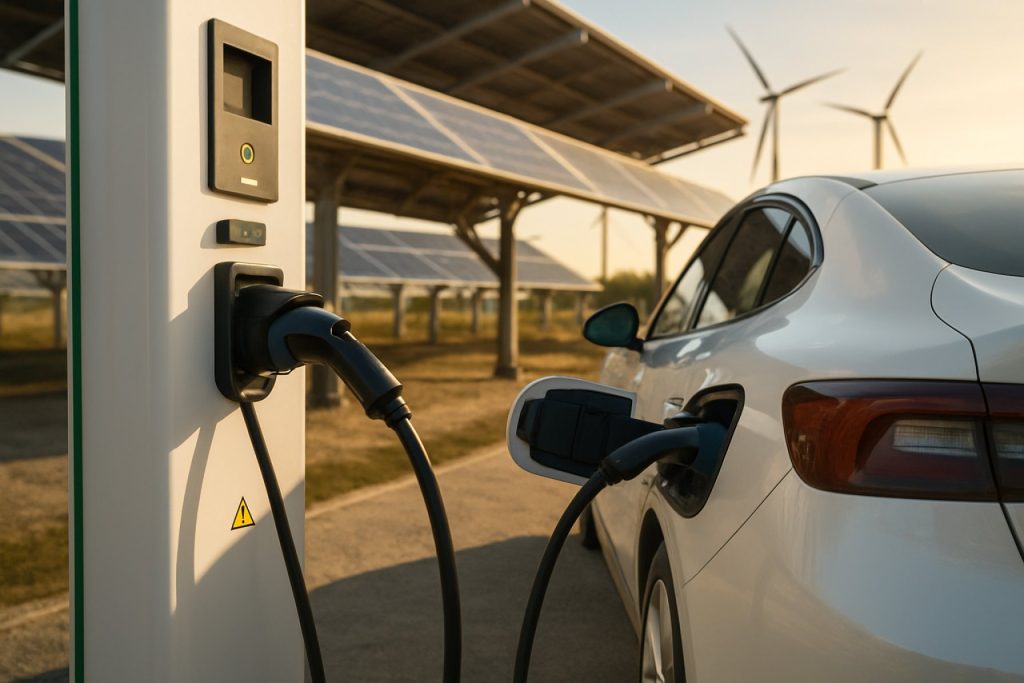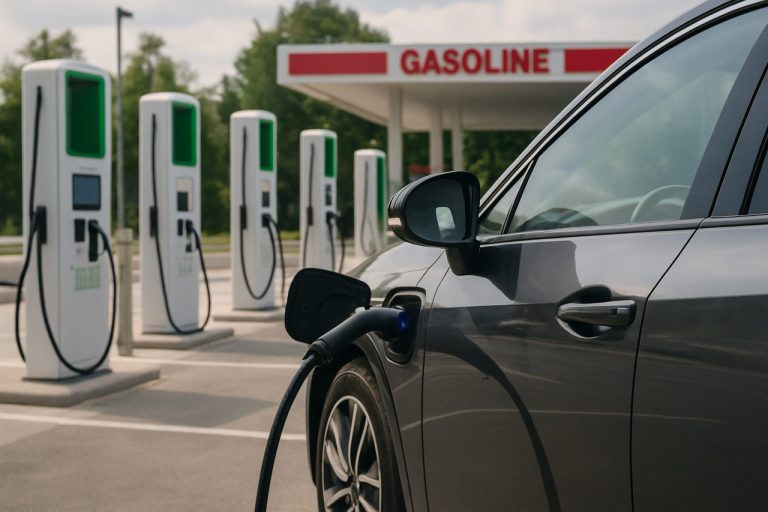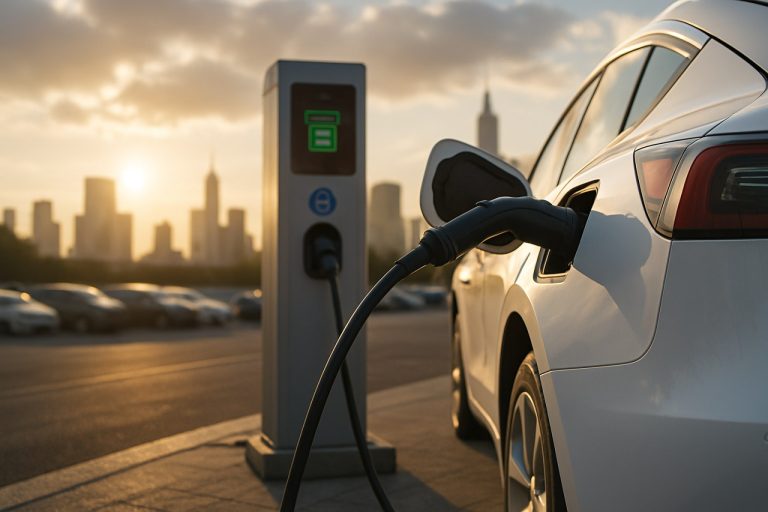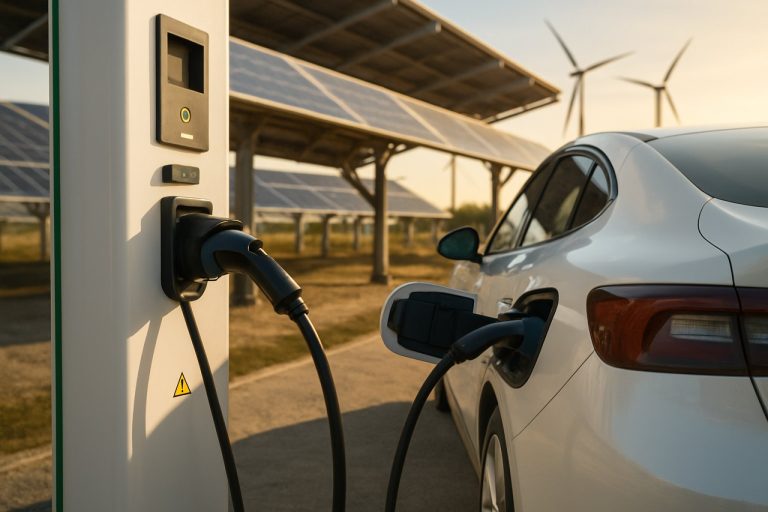
- Battery gigafactories are rapidly expanding worldwide, driving a massive surge in electric vehicle (EV) battery production to over 5,000 gigawatt-hours annually by 2030.
- Government mandates to phase out internal combustion engines and reduce emissions are intensifying demand for lithium, nickel, and cobalt, increasing global mining and boosting investments in sustainable sourcing and recycling.
- Lithium iron phosphate (LFP) and nickel-manganese-cobalt (NMC) batteries dominate current EVs, while solid-state batteries promise safer, faster-charging technology in the near future.
- Major players like CATL, LG Energy Solution, Northvolt, and Samsung SDI are scaling up localized battery manufacturing, while recycling innovators help reduce environmental impact.
- Battery advances are making EVs more affordable and mainstream, accelerating a global shift toward cleaner transportation and reshaping mobility for both economies and daily life.
Battery gigafactories blaze across landscapes from Texas to Tianjin, transforming the humdrum world of car manufacturing into a high-stakes global contest. Giant robotic arms weld, test, and pack lithium-ion cells with the precision of clockwork, each movement a beat in the relentless rhythm of the electric age. The numbers astonish: by 2030, annual electric vehicle (EV) battery production is set to shatter records, vaulting past 5,000 gigawatt-hours — enough to power more than 60 million electric cars a year.
Driving this dramatic surge isn’t just consumer appetite for zero-emission vehicles. Governments in Europe, the United States, China, and India have issued bold mandates: phase out internal combustion engines, slash carbon emissions, and secure energy independence. As these policies take root, the world’s appetite for lithium, nickel, and cobalt has reached a fever pitch, with mining operations expanding from Australia’s Outback to Chile’s Atacama brine pools. Meanwhile, forward-thinking companies invest feverishly in sustainable sourcing and advanced recycling to avoid the pitfalls of resource depletion and environmental harm.
At the heart of this feverish scramble lies a quietly radical transformation in battery technology. Lithium iron phosphate (LFP) batteries, championed by leaders like Tesla and BYD, have matured from obscure alternatives to global workhorses. They deliver dependability with lower costs and robust safety records, ideal for mass-market models. Meanwhile, nickel-manganese-cobalt (NMC) formulations unlock new promises for drivers who crave longer range and faster charges. Yet all eyes are on solid-state batteries — a moonshot pursued by industry titans such as Toyota, Panasonic, and QuantumScape. These next-generation cells may halve charging times and slash fire risks, a leap that could tip the scales for millions of wary car buyers.
Manufacturing ambitions match technological leaps. Players like CATL and LG Energy Solution are scaling up to unprecedented heights, with gigafactories sprawling across Asia, Europe, and North America. Sweden’s Northvolt and South Korea’s Samsung SDI lead the charge in localized production, buffered from the geopolitical tremors that shake global trade. Recycling crusaders such as Umicore and Redwood Materials hunt for ways to recover lithium, cobalt, and nickel from spent batteries, forging closed loops that could rewrite the supply chain’s climate impact.
India, a nation with soaring urban populations and fierce air quality challenges, surges forward with massive domestic investments and government-backed incentives. Its ambition? To become the battery belt of Asia, producing not just for homegrown EVs but for the world — a momentous shift that promises economic uplift alongside cleaner cities.
For the consumer, these seismic changes mean more than just greener credentials. As battery prices tumble and technology advances, electric vehicles rapidly shed their luxury tag, driving into the heart of the mainstream. Choice multiplies, ownership costs shrink, and neighborhood air grows noticeably cleaner.
Yet, the central truth is unmistakable: batteries are now the arteries of a new mobility ecosystem. Their surging production capacity, innovative chemistry, and commitment to sustainability form the backbone of an industrial transformation. The race from oil to electrons is accelerating, reshaping cities, economies, and everyday life. The next five years will decide whether this momentum is mere promise — or an irreversible leap toward a cleaner, electrified future.
To keep track of the fast-evolving world of technology and mobility, stay connected with cutting-edge insights at Bloomberg and for the latest advances in global EV trends, explore Tesla and BYD.
Takeaway: The world is powering up for its biggest energy shift yet. As battery technology evolves and global production explodes, the future of transport — cleaner, cheaper, and more accessible — is arriving well ahead of schedule.
The Battery Boom: How Gigafactories and Cutting-Edge Tech Are Revolutionizing Your Ride—and the World
The Battery Revolution: What the Source Article Missed
The explosive rise of battery gigafactories is more than just an industrial marvel—it’s a harbinger of sweeping change across the automotive, energy, and technology sectors. While the source covered blockbuster forecasts and the political drive behind this surge, there’s much more under the surface. Let’s break down the details you should know, answer key questions, and give you actionable tips to navigate this electrified future.
—
1. Beyond the Hype: Advanced Battery Chemistries Explained
LFP vs NMC vs Solid-State—What’s the Difference?
– Lithium Iron Phosphate (LFP) Batteries
– Pros: Extremely safe; longer cycle life; lower cost (no cobalt).
– Cons: Slightly lower energy density than NMC—means shorter range in compact designs.
– Notable Use: Dominant in affordable EVs in China; now widely adopted by Tesla. ([source: Bloomberg](https://www.bloomberg.com))
– Nickel Manganese Cobalt (NMC) Batteries
– Pros: Higher energy density for longer range; adopted for performance/luxury EVs.
– Cons: Expensive due to cobalt; controversial mining practices.
– Industry Insight: Automakers are racing to reduce cobalt for cost and ethical reasons.
– Solid-State Batteries
– Pros: Dramatic safety improvement; potentially double the energy density.
– Cons: Cost, scalability, and longevity are still hurdles.
– When to Expect: Experts like Toyota target commercialization by 2027–2028, but mass adoption may come later ([source: Reuters](https://www.reuters.com)).
—
2. Key Features & Specs
– Gigafactory Scale: The largest plants (e.g., CATL, Tesla Gigafactory Nevada) are surpassing 100 GWh annual capacity—enough for over a million EVs each year.
– Energy Density Trends: Leading NMC cells exceed 250 Wh/kg, while LFP hovers around 160–180 Wh/kg but is catching up.
– Cost Trajectory: Battery pack costs have dropped from $1,100/kWh (2010) to ~$139/kWh (2023) ([source: BloombergNEF](https://www.bloomberg.com)) and are projected to sink below $100/kWh by 2026—unlocking true EV parity with gas vehicles.
—
3. Real-World Impact: Ownership & Life Hacks
How-To: Maximizing EV Battery Life
– Avoid frequent fast charging to reduce long-term degradation.
– Keep state-of-charge between 20%-80% for daily use.
– Use regenerative braking to recapture energy and reduce wear.
Home Charging:
– Install a Level 2 charger for faster, convenient overnight charging.
– Pair with rooftop solar to power your EV (and home) sustainably.
Cost Savings: With fewer moving parts and less required maintenance, EV owners save an average of 40–60% on annual service costs compared to conventional vehicles ([source: U.S. Department of Energy](https://www.energy.gov)).
—
4. Industry Trends, Forecasts & Market Controversies
– Recycling Boom: Companies like Redwood Materials and Umicore are scaling up battery recycling—projected to supply up to 20% of critical EV battery materials by 2035.
– Second-Life Batteries: Repurposed EV batteries are powering grids and homes as stationary storage solutions, extending their usefulness far beyond their initial automotive life.
– Resource Race & ESG Controversy: Intense demand for lithium, cobalt, and nickel is fueling new mining ventures. NGOs and watchdogs warn of environmental and human rights risks, particularly in the Congo (for cobalt).
– Sustainable Sourcing: Automakers and suppliers increasingly sign direct contracts with mines and participate in traceability programs.
– Geo-Politics: The U.S. “Inflation Reduction Act” incentivizes local battery production. Europe is racing to secure raw materials and build capacity with strategic “Battery Alliances.”
—
5. Security, Sustainability, and Limitations
Safety
– LFP batteries are less prone to thermal runaway (battery fires). Major EV manufacturers now favor them for this reason.
– Solid-state batteries are expected to dramatically reduce fire risk.
Limitations/Cons
– Range Anxiety persists, but new models with 350+ miles of range are narrowing the gap.
– Cold-weather performance is improving with advanced battery management systems. Heat pumps are standard in many new EVs.
Sustainability
– Water usage and environmental disruption in lithium extraction locations (Chile, Argentina) are under scrutiny.
– Closed-loop recycling and new solvent-free manufacturing techniques are in rapid development.
—
6. Reviews & Comparisons
– Tesla Model 3 (LFP vs NMC): Recent standard-range Teslas use LFP for longevity and cost; Long Range/Performance versions stick with NMC for superior range.
– BYD vs LG Energy Solution: BYD uses its own “Blade” LFP batteries—renowned for safety and long life. LG Energy Solution is innovating with NMC and solid-state partnerships.
—
7. Answers to Pressing Reader Questions
Q: Are EV batteries really environmentally friendly?
– Only if paired with renewable electricity and robust recycling. Battery tech is moving towards more ethical sourcing, but vigilance is needed. ([source: International Energy Agency](https://www.iea.org))
Q: How long do EV batteries last?
– Modern EV batteries are expected to exceed 300,000 miles (15+ years) with >70% original capacity.
Q: Can homeowners go off-grid with EV batteries?
– Yes—“vehicle-to-grid” tech lets some EVs power homes during outages (notably Nissan Leaf, Ford F-150 Lightning).
—
8. Quick Tips & Recommendations
– Thinking of buying an EV? Consider new models with LFP packs for daily commuting—they’re safer, need less maintenance, and tolerate regular full charges.
– Join a local or online EV user group for optimal charging/range practices and shared knowledge.
– Invest if you can in home battery storage; gigafactory growth is making stationary storage cheaper month by month.
– Stay informed—monitor tech and policy changes at leading sites like Bloomberg, Tesla, and BYD.
—
The Bottom Line
The battle over battery supremacy is remaking every facet of energy, mobility, and industry. Costs will drop, options will explode, and the green transition is accelerating—making now the best time to get savvy about the EV and battery revolution. Whether you’re a car buyer, homeowner, investor, or simply an interested observer, knowing these deeper details will keep you ahead as the electric era charges in.
—
Keywords: Battery gigafactories, lithium iron phosphate, LFP vs NMC, solid-state battery, EV trends, battery recycling, renewable energy storage, gigafactory market, electric vehicle ownership, battery supply chain, EV battery life tips
For up-to-date news and expert insights, don’t forget to visit Bloomberg, Tesla, and BYD.



